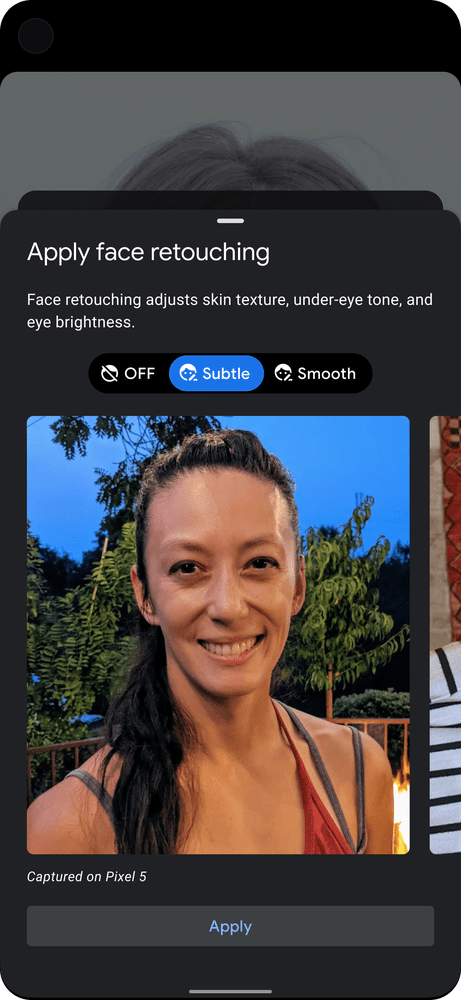
I’m not a selfie guy. Raising my hand and pointing my phone at my own face never quite felt natural to me. Sure, I’ve done it a bunch of times, but it never really got any less awkward. It never felt like me.
Because it wasn’t me.
There has long been whispers about phone cameras secretly post-processing your selfies to make you “more beautiful,” with the iPhone XS “Beautygate” scandal perhaps being the most notorious instance of this trend.
Critics have argued such automated edits fundamentally cultivate a culture of unobtainable beauty standards, which in turn leads to more extreme urges to manipulate our image — there are plenty of examples of pushing this beyond the norm in the popular Instagram versus Reality subreddit.
It seems Google has decided to take a stand against this tendency, though.
In a blog post, the company announced it will now disable selfie retouching by default, starting with its latest Pixel devices — the 4a, the 4a 5G, and the 5.
To be clear, Google isn’t getting rid of filters altogether — it’s simply letting you choose when and if you want to use them. It’s also updating the user interface of its camera app to highlight the ways in which each filter changes your image.
“We created a framework to build and design products that support your wellbeing as well as an intentional relationship with technology,” Google product manager Vinit Modi wrote. “This means you should get to choose if and when your appearance is changed in pictures.”

As someone who dabbles in photography, I’m not at all opposed to image manipulation — especially for creative purposes. In fact, most of my pics are heavily edited, which is why I always drop a disclaimer and upload the original photos for comparison in camera reviews.
There’s an undercurrent of photographers who make it their top priority to avoid post-processing at all costs, seeking to capture the moment as candidly as they can. I’ve got lots of admiration for the work some of these artists produce, but I personally lean towards the other extreme — I find post-processing infinitely more fascinating.
As much as pressing the shutter button at the right time matters, my favorite part of the photographic process is going back home and loading up my images in Lightroom and Photoshop. This is when I feel most in control of my work, this is how I leave my signature touch in my photography.
I’m not saying that’s the right way to do things, but it’s the only way I’m interested in pursuing.
Automatic selfie post-processing isn’t the same though — and a huge part of the problem is that lots of phone-makers choose to enable it by default.
Applying filters to images by default practically obfuscates the editing process. The original pic is erased and quietly replaced by a “beautified” alternative, which now effectively poses as the original itself. With the history of modifications absent, the alternative is the original.
There’s noting inherently wrong with that, but things get a little more nuanced when the subject of those “invisible” edits is us.
“We set out to better understand the effect filtered selfies might have on people’s wellbeing — especially when filters are on by default,” Google explains. “We conducted multiple studies and spoke with child and mental health experts from around the world, and found that when you’re not aware that a camera or photo app has applied a filter, the photos can negatively impact mental wellbeing.”
“These default filters can quietly set a beauty standard that some people compare themselves against,” it adds.
It’s worth noting this approach is somewhat new to Google’s philosophy on photography.
Although I loved the photos I snapped with my Pixel 4, one bit that rubbed me the wrong way was how intrusively Google was pushing its own computational post-processing on the images. The fact the device came without a dedicated pro mode in the camera app is quite telling.
The thing is, Google is not the only one to do this. Each big-time phone-maker has crafted a distinct look for its camera app — and post-processing plays a central role. Marques Brownlee has repeatedly nailed this point down with his series of blind camera tests.
But while there are minor differences between the approach each manufacturer takes to color science and post-processing, all of these styles have been developed to fit the norm — not your personal style.
With selfies, though, the norm becomes a beauty standard.
So when your phone touches up your face, smoothens your skin, removes the bags under your eyes, it effectively conceals the sadness and joy you’ve experienced, the marks time has left on you, the glitter in your iris. It doesn’t simply edit out your imperfections — it overwrites your existence.
The image you see in that selfie isn’t a fragment of you frozen in time. It’s a commodified alternative designed in the blueprint of social media beautification that’s violently seeking to replace the original, to make you fit norm.
There’s nothing wrong with manipulating our looks if we so choose, so, by all means, keep making filters. But we shouldn’t let software control our image and dictate the way we look at ourselves — and I hope Google is only the first of many manufacturers to realize this.
Get the TNW newsletter
Get the most important tech news in your inbox each week.




